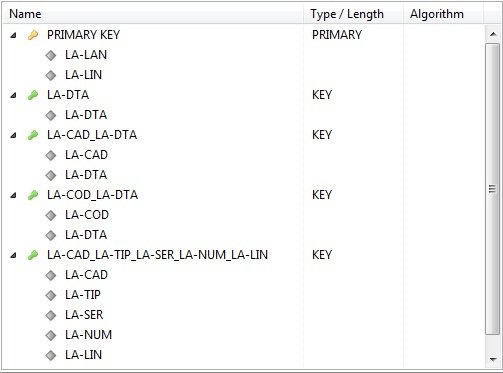|
COBOL & Mysql cobol and MYSQL easy to use. |
Creating Mysql table |
| 1 | Install Mysql server. | ||||||||||||||||||
| 2 | Install a IDE that makes easy to handle and maintain Mysql tables. We recommend HeidiSQL that besides an excellent tool, and is free, you will find in http://www.heidisql.com for download. | ||||||||||||||||||
| 3 | Suppose that the server is installed on the user machine, in this case the server address will be 127.0.0.1. | ||||||||||||||||||
| 4 |
In order to
establish a relationship
between the table in MySQL and
FD of our
application,
We created the following
table of
equivalence:
|
||||||||||||||||||
| 5 | Fields with Occurs, and redefines should be treated as follows: | ||||||||||||||||||
| 5.1 |
Occurs, create the
field N
times, as many
times it occurs. EX.: Na FD.
02 CAMPO-A OCCURS 10.
03 DADO1 PIC X(2).
03 DADO2 PIC X(3).
Should be
defined as folow.
`DADO1-01` char(2) NOT NULL, `DADO2-01` char(3) NOT NULL, `DADO1-02` char(2) NOT NULL, `DADO2-02` char(3) NOT NULL, `DADO1-03` char(2) NOT NULL, `DADO2-03` char(3) NOT NULL, ... `DADO1-10` char(2) NOT NULL, `DADO2-10` char(3) NOT NULL, |
||||||||||||||||||
| 5.2 |
REDEFINES
is not allowed. In this case the
REDEFINES should
be eliminated, and you will need to
recode your program. Eventually the User may have the following situation as described in the table below:
|
BIB2SQL.EXE
To facilitate the
correct definition
of the columns in the tables
we created
the program BIB2SQL.EXE.
From a text file containing the definitions of FD, as far as possible, this routine will create a new text file, containing all necessary commands to create equivalent table provided with suffix "SQL".
Fields defined with Occurs and redefines, should receive additional treatment.
Just run BIB2SQL with no parameter, that it returned the SYNTAX necessary for its execution.
Syntax :
From a text file containing the definitions of FD, as far as possible, this routine will create a new text file, containing all necessary commands to create equivalent table provided with suffix "SQL".
Fields defined with Occurs and redefines, should receive additional treatment.
Just run BIB2SQL with no parameter, that it returned the SYNTAX necessary for its execution.
Syntax :
BIB2SQL nomearqBib@nomeTabela@nomeDB
Note that was used "@" as separator parameters, where nomearqBib is the name of the text file containing the FD definition, nomeTabela name of the table and nomeDB, the name of the database where the table will be inserted.Ex.:
EXT2SQL ARQMYS.FD@arqmys@francodb
| Text file containing the FD definition, ARQMYS.FD | Will crate | SQL script file ARQMYS.SQL |
01 MY-REG.
02 MY-SIT PIC X(01).
02 MY-LAN PIC S9(09) COMP-3.
02 MY-CTA PIC S9(15) COMP-3.
02 MY-CDH PIC S9(05) COMP-3.
02 MY-HST PIC X(30).
02 MY-DTA PIC S9(09) COMP-3.
02 MY-VAL PIC S9(13)V99 COMP-3.
|
CREATE TABLE `francodb`.`arqmys` ( `MY-SIT` CHAR(00001) NOT NULL DEFAULT ' ', `MY-LAN` DECIMAL(00009) NOT NULL DEFAULT '0', `MY-CTA` DECIMAL(00015) NOT NULL DEFAULT '0', `MY-CDH` DECIMAL(00005) NOT NULL DEFAULT '0', `MY-HST` CHAR(00030) NOT NULL DEFAULT ' ', `MY-DTA` DECIMAL(00009) NOT NULL DEFAULT '0', `MY-VAL` DECIMAL(00015,00002) NOT NULL DEFAULT '0' ) ENGINE=InnoDB; |

Until now we created the table with their respective columns, based on the FD, and in accordance with the pre set for above equivalences.
It remains to define the all keys, so you can obtain the same results as far as accessing via file and MF Mysql.
Ex.:how to define keys in Mysql, meeting prerequisites of EXTMYSQL.
SELECT ARQMYS ASSIGN TO DYNAMIC W-LABMSQ
ORGANIZATION IS INDEXED
ACCESS MODE IS DYNAMIC
FILE STATUS IS W-STATUS
RECORD KEY IS MY-LAN
ALTERNATE RECORD KEY IS MY-CTA
WITH DUPLICATES.
|
 |
SELECT SCCMOV ASSIGN TO DYNAMIC W-ARQUIVOS
ORGANIZATION IS INDEXED
ACCESS MODE IS DYNAMIC
FILE STATUS IS W-STATUS
RECORD KEY IS LA-LNC = LA-LAN LA-LIN
ALTERNATE RECORD KEY IS LA-DTA
WITH DUPLICATES
ALTERNATE RECORD KEY IS LA-CDA = LA-CAD LA-DTA
WITH DUPLICATES
ALTERNATE RECORD KEY IS LA-CDO = LA-COD LA-DTA
WITH DUPLICATES
ALTERNATE RECORD KEY IS LA-DOA = LA-CAD LA-TIP
LA-SER LANUM LA-LIN
WITH DUPLICATES
|
 |
To define composite keys, simply include all fields in the same sequence of keys on the table as it was defined in yout traditional SELECT.
The definition of each key in the right sequence as it was defined in your SELECT, is fundamental to obtain the same results in both MF files and MYSQL.
Note: The EXTMYSQL does not address the key defined in the table by name, but by the sequence in which it was defined, so the primary key must be the first key, the first Secondary key is the second key, and so on, regardless of name given key.
Warnings:
Before any procedure, it is essential to have backup. Backup of programs and data is mandatory.Errors:
| 1 | I can not get the same result reading MF file and MYSQL table. |
|
In this case
it is possible that you
have a sequence error
in keys definition. Refresh
HeidiSQL and check if all the keys
are properly
defined, and mostly
in the right sequence. Whenever you change any information on the key defined, make sure the keys still defined in the original sequence. In some cases the key changed is placed at the end as the last key, interfering the way our program will make your hits, and this is only identified after running the REFRESH command. |